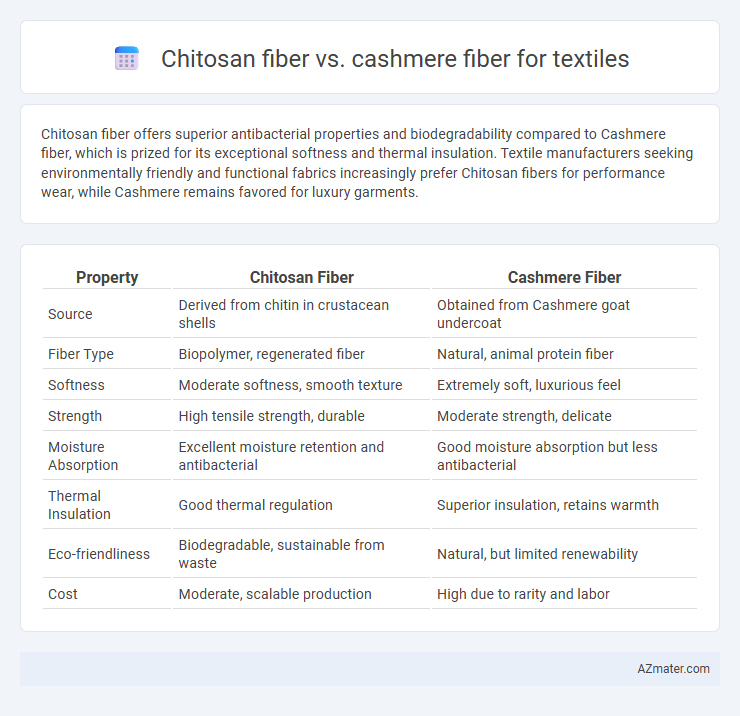Chitosan fiber offers superior antibacterial properties and biodegradability compared to Cashmere fiber, which is prized for its exceptional softness and thermal insulation. Textile manufacturers seeking environmentally friendly and functional fabrics increasingly prefer Chitosan fibers for performance wear, while Cashmere remains favored for luxury garments.
Table of Comparison
| Property | Chitosan Fiber | Cashmere Fiber |
|---|---|---|
| Source | Derived from chitin in crustacean shells | Obtained from Cashmere goat undercoat |
| Fiber Type | Biopolymer, regenerated fiber | Natural, animal protein fiber |
| Softness | Moderate softness, smooth texture | Extremely soft, luxurious feel |
| Strength | High tensile strength, durable | Moderate strength, delicate |
| Moisture Absorption | Excellent moisture retention and antibacterial | Good moisture absorption but less antibacterial |
| Thermal Insulation | Good thermal regulation | Superior insulation, retains warmth |
| Eco-friendliness | Biodegradable, sustainable from waste | Natural, but limited renewability |
| Cost | Moderate, scalable production | High due to rarity and labor |
Overview of Chitosan Fiber and Cashmere Fiber
Chitosan fiber, derived from chitin found in crustacean shells, offers antimicrobial properties and biodegradability, making it a sustainable option in textile manufacturing. Cashmere fiber, sourced from the undercoat of cashmere goats, is renowned for its exceptional softness, warmth, and lightweight nature, commanding a premium price in luxury fabric markets. While chitosan fiber emphasizes eco-friendliness and functional benefits, cashmere remains prized for its natural insulation and high-end comfort in apparel.
Origin and Source of Each Fiber
Chitosan fiber originates from the natural polysaccharide chitin, predominantly sourced from the exoskeletons of crustaceans such as shrimp and crabs, making it a sustainable and biodegradable option for textiles. In contrast, cashmere fiber is a luxury natural protein fiber obtained from the undercoat of cashmere goats primarily found in regions like Mongolia, China, and Iran. The differing origins influence their texture, durability, and applications, with chitosan offering antimicrobial properties and cashmere prized for its softness and thermal insulation.
Fiber Structure and Chemical Composition
Chitosan fiber is derived from chitin, primarily consisting of b-(1-4)-linked D-glucosamine units, which provide inherent antimicrobial properties and a rigid, crystalline fiber structure contributing to durability in textiles. Cashmere fiber, composed mainly of keratin proteins rich in cysteine, features a fine, soft, and flexible structure with scale-like cuticles that enhance warmth and moisture retention. The chemical composition of chitosan fibers imparts biodegradability and moisture management, whereas cashmere's protein-based composition results in exceptional insulation and a luxurious hand feel.
Sustainability and Environmental Impact
Chitosan fiber, derived from chitin found in crustacean shells, offers a biodegradable and renewable alternative to traditional textiles, significantly reducing environmental impact due to its natural antimicrobial properties and minimal chemical processing. Cashmere fiber, sourced from the undercoat of cashmere goats, presents sustainability challenges, including overgrazing and habitat degradation, which contribute to soil erosion and biodiversity loss. The ecological footprint of chitosan fiber is notably lower than cashmere, making it a more sustainable choice for eco-conscious textile manufacturing.
Softness and Comfort Comparison
Chitosan fiber offers exceptional softness due to its smooth surface and natural biocompatibility, enhancing skin comfort and breathability in textile applications. Cashmere fiber is renowned for its luxurious softness and warmth, derived from fine, lightweight fibers that provide superior insulation and a plush feel. While cashmere excels in warmth and traditional comfort, chitosan fibers deliver hypoallergenic properties and moisture-wicking benefits, making them ideal for sensitive skin and active wear.
Durability and Longevity
Chitosan fiber exhibits superior durability in textiles due to its antimicrobial properties and resistance to wear, making it less prone to degradation over time compared to Cashmere fiber. Cashmere offers exceptional softness but is more susceptible to pilling and fiber breakage, reducing its longevity under frequent use and washing. Textiles made from Chitosan fiber tend to maintain structural integrity longer, providing enhanced lifespan in clothing and upholstery applications.
Moisture Absorption and Breathability
Chitosan fiber exhibits superior moisture absorption due to its natural hydrophilic properties and porous structure, which effectively wick moisture away from the skin. Cashmere fiber, while providing excellent insulation and softness, has moderate moisture absorption and breathability compared to chitosan, as its dense fiber structure limits airflow. Textile applications requiring high-performance moisture management and ventilation benefit more from chitosan fibers than traditional cashmere fibers.
Potential Allergenic Effects
Chitosan fiber exhibits hypoallergenic properties due to its natural antimicrobial and biocompatible characteristics, reducing the risk of skin irritation compared to traditional fibers. Cashmere fiber, derived from goat hair, can cause allergic reactions in sensitive individuals because of its protein-based structure and the presence of lanolin. Evaluating allergenic potential, chitosan fiber offers a safer alternative for textile applications targeting consumers with sensitive or allergy-prone skin.
Cost and Market Availability
Chitosan fiber, derived from chitin in crustacean shells, offers a cost-effective alternative to luxury cashmere fiber, with production costs significantly lower due to abundant raw materials and simpler processing methods. Cashmere fiber, known for its rarity and softness, commands a high market price because it comes from limited sources such as cashmere goats in specific regions like Mongolia and China. Market availability for chitosan fiber is expanding rapidly owing to increasing demand for sustainable textiles, while cashmere remains niche with seasonal supply constraints and higher import tariffs impacting its accessibility globally.
Applications in Modern Textiles
Chitosan fiber offers antimicrobial properties, biodegradability, and moisture management, making it ideal for sportswear, medical textiles, and eco-friendly fashion. Cashmere fiber excels in thermal insulation, softness, and luxury appeal, commonly used in high-end apparel and winter garments. Modern textiles integrate chitosan for functional performance and cashmere for premium comfort, targeting diverse markets from sustainable activewear to luxury knitwear.

Infographic: Chitosan fiber vs Cashmere fiber for Textile
 azmater.com
azmater.com